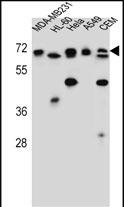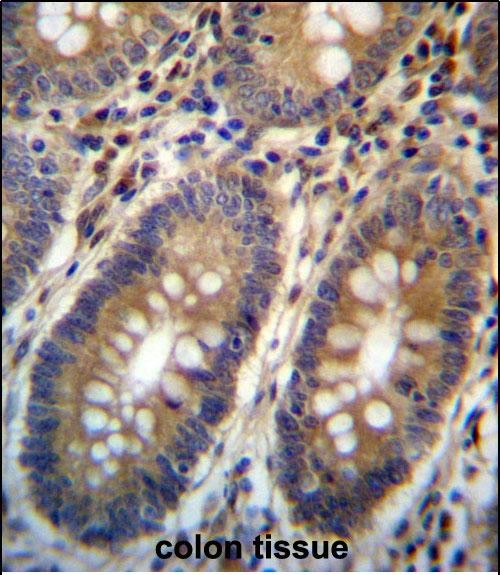ASMTL Antibody (Center)
Affinity Purified Rabbit Polyclonal Antibody (Pab)
- 产品详情
- 实验流程
- 背景知识
Application
| WB, IHC-P, E |
|---|---|
| Primary Accession | O95671 |
| Other Accession | NP_001166945.1, NP_004183.2 |
| Reactivity | Human |
| Host | Rabbit |
| Clonality | Polyclonal |
| Isotype | Rabbit IgG |
| Calculated MW | 68857 Da |
| Antigen Region | 231-259 aa |
| Gene ID | 8623 |
|---|---|
| Other Names | N-acetylserotonin O-methyltransferase-like protein, ASMTL, 211-, ASMTL |
| Target/Specificity | This ASMTL antibody is generated from rabbits immunized with a KLH conjugated synthetic peptide between 231-259 amino acids from the Central region of human ASMTL. |
| Dilution | WB~~1:1000 IHC-P~~1:100~500 E~~Use at an assay dependent concentration. |
| Format | Purified polyclonal antibody supplied in PBS with 0.09% (W/V) sodium azide. This antibody is purified through a protein A column, followed by peptide affinity purification. |
| Storage | Maintain refrigerated at 2-8°C for up to 2 weeks. For long term storage store at -20°C in small aliquots to prevent freeze-thaw cycles. |
| Precautions | ASMTL Antibody (Center) is for research use only and not for use in diagnostic or therapeutic procedures. |
| Name | ASMTL |
|---|---|
| Function | Nucleoside triphosphate pyrophosphatase that hydrolyzes dTTP and UTP. Can also hydrolyze CTP and the modified nucleotides pseudo- UTP, 5-methyl-UTP (m(5)UTP) and 5-methyl-CTP (m(5)CTP). Has weak activity with dCTP, 8-oxo-GTP and N(4)-methyl-dCTP (PubMed:24210219). May have a dual role in cell division arrest and in preventing the incorporation of modified nucleotides into cellular nucleic acids (PubMed:24210219). In addition, the presence of the putative catalytic domain of S-adenosyl-L-methionine binding in the C-terminal region argues for a methyltransferase activity (Probable). |
| Tissue Location | Widely expressed. In adult, highly expressed in pancreas, placenta, fibroblast, thymus, prostate, testis, ovary and colon. Expressed at lower levels in spleen, small intestine and leukocytes. In fetus, expressed at high levels in the lung and kidney and at lower level in brain and liver |
For Research Use Only. Not For Use In Diagnostic Procedures.
Provided below are standard protocols that you may find useful for product applications.
BACKGROUND
The protein encoded by this gene has an N-terminus that is similar to the multicopy associated filamentation (maf) protein of Bacillus subtilis and to orfE of Escherichia coli, while the C-terminus is similar to N-acetylserotonin O-methyltransferase. This gene is located in the pseudoautosomal region 1 (PAR1) of X and Y chromosomes. Three transcript variants encoding different isoforms have been found for this gene.
REFERENCES
Olsen, J.V., et al. Cell 127(3):635-648(2006)
Olsen, J.V., et al. Cell 127(3):635-648(2006)
Ried, K., et al. Hum. Mol. Genet. 7(11):1771-1778(1998)
终于等到您。ABCEPTA(百远生物)抗体产品。
点击下方“我要评价 ”按钮提交您的反馈信息,您的反馈和评价是我们最宝贵的财富之一,
我们将在1-3个工作日内处理您的反馈信息。
如有疑问,联系:0512-88856768 tech-china@abcepta.com.























 癌症的基本特征包括细胞增殖、血管生成、迁移、凋亡逃避机制和细胞永生等。找到癌症发生过程中这些通路的关键标记物和对应的抗体用于检测至关重要。
癌症的基本特征包括细胞增殖、血管生成、迁移、凋亡逃避机制和细胞永生等。找到癌症发生过程中这些通路的关键标记物和对应的抗体用于检测至关重要。 为您推荐一个泛素化位点预测神器——泛素化分析工具,可以为您的蛋白的泛素化位点作出预测和评分。
为您推荐一个泛素化位点预测神器——泛素化分析工具,可以为您的蛋白的泛素化位点作出预测和评分。 细胞自噬受体图形绘图工具为你的蛋白的细胞受体结合位点作出预测和评分,识别结合到自噬通路中的蛋白是非常重要的,便于让我们理解自噬在正常生理、病理过程中的作用,如发育、细胞分化、神经退化性疾病、压力条件下、感染和癌症。
细胞自噬受体图形绘图工具为你的蛋白的细胞受体结合位点作出预测和评分,识别结合到自噬通路中的蛋白是非常重要的,便于让我们理解自噬在正常生理、病理过程中的作用,如发育、细胞分化、神经退化性疾病、压力条件下、感染和癌症。







